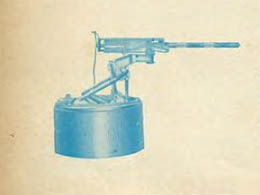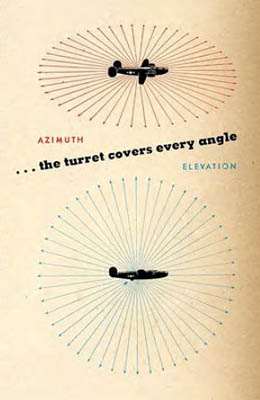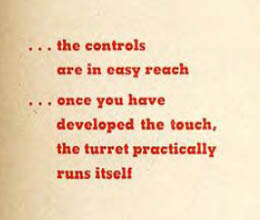The importance of the modern power gun turret to U.S. bombers in WW2 from Aircrewman’s Gunnery Manual, Aviation Training Division, Office of the Chief of Naval Operations, U.S. Navy, 1944
Thanks to the Turret… THE BOMBER FIGHTS BACK
- Without the men who invented the turret, today’s great bombing missions would be impossible. For without turrets, the bomber would be almost as helpless over enemy territory as an ordinary transport plane without a single gun.
- No one knows exactly who should get credit for inventing the modern turret. The first crude models came out in the 1920’s. One was a circular mount, illustrated on this page, which the United States developed to put a little flexibility into bomber guns. The Russians tried a movable platform, cranked by hand, in which the gunner sat right out in the open, fighting the slipstream as well as the enemy.
- The modern power turret–driven by electricity and mounted inside the bomber–was developed after many experiments in the 1930’s and proved its worth in action in the second year of World War II. Its effect on air strategy was spectacular. At last the bomber–heavier and slower than the fighter plane–could really fight back.
- For turrets–little blisters of plexiglas or safety glass, bristling with caliber .50s, swinging around to meet enemy fighters no matter where they come from–enable the bomber to match the enemy slug for slug in an air battle.
- Approach an American bomber today, from any angle, and you will see a turret whose guns could be turned toward you in an instant.
- The top turret swings in a full circle; its guns move up and down from straight out to nearly straight up; it protects the whole top of the plane.
- The lower ball turret swings in a full circle and points its guns anywhere from straight out to straight down; it can fight off any attacker who comes from below. The tail turret throws out a big cone of fire toward the rear, and the nose or chin turret a heavy cone of fire straight ahead.
- Along with hand-held guns sticking out the waist windows and the radio position, the turrets cover almost every square inch of sky around the bomber. No matter where the enemy fighter comes from, he must take his chances with a hail of caliber .50 bullets.
- The turrets are spun around, and the guns raised and lowered, by electric motors or by hydraulic pressure systems run by electric motors. (In the language of turrets, swinging from side to side is called moving in azimuth; up and down movement is called elevation.) All the gunner has to do is hold on to the control handles of his guns and move them to steer the turret; the mechanism does the rest.
- Inside the turret is everything the gunner needs for combat, arranged so that he can get at it in an instant. No space is wasted; although turrets are small, they have everything it takes to fight the enemy.
- As a turret gunner–no matter which turret you are assigned to you will ride into combat seated in back of caliber .50 machine guns and a sight. Often your seat and footrests will be adjustable; if so, learn to use the adjustments properly and you will find them a great aid to both your comfort and your efficiency.
- Armor plate or bulletproof glass will protect you as much as possible–though your best defense, like a good boxer’s, will still be the offensive power packed by those caliber .50s.
- Your guns will be equipped with a special charging system–usually a pulley and cable–which makes it easy to hand charge them in the crowded space of the turret. The guns will be mounted in adapters which cushion their recoil. You will fire them by pressing triggers, usually under your index fingers on the control handles, which release the firing pins by means of electrical devices called ELECTRIC TRIGGERS.
- Ammunition for the guns–enough to carry you through any mission if you don’t waste it–will ride in cans mounted so that the belt runs smoothly into the feedways. Often BOOSTER MOTORS will help lift the belt to the guns. And often the empty cases will drop through special EJECTION CHUTES out of the turret or into SPENT ROUND BAGS attached to the ends of the chutes.
- As you swing the guns around, you won’t have to worry about shooting at parts of your own bomber. Every turret where this danger exists has a system of FIRE INTERRUPTION, or FIRE CUTOFF, which stops the guns automatically when they are pointed toward any part of the bomber.
- Nor will you have to worry about swinging the guns so far that they bang into your own ship. Turrets have LIMIT STOPS which prevent that. On some turrets the limit stops are simply bumpers; others, in addition, have automatic switches which halt the turret before any damage can be done.
- All the switches you need to operate the turret will be located within easy reach. The control handles will enable you to run the turret as easily as an automobile. Once you have developed the touch–the secret is to keep a steady hand, without jerking–you will be able to track the enemy smoothly and accurately.
- For whirling around quickly to meet a new attack, your turret will be able to get up to high speed. The distance you move the control handles will determine the speed–and in some turrets you will have a special high speed button which throws the turret into high gear to give you an extra boost. If your turret has a high speed button, use it only when you really need it–to avoid unnecessary wear and tear on the power system.
- If the turret power should ever fail, you will usually have a MANUAL SYSTEM for operating it by hand cranks. Some turrets even have foot pedals which enable you to fire the guns while using both hands to crank the turret into position. This is an important emergency protection; use it to keep your guns pointed at enemy fighters even though your fire cannot possibly be so accurate as when the power is on, for a motionless turret is an invitation for fighters to attack.
- Even if the guns are out of order, keep tracking the enemy; if you can’t hit him, you may at least scare him away.












